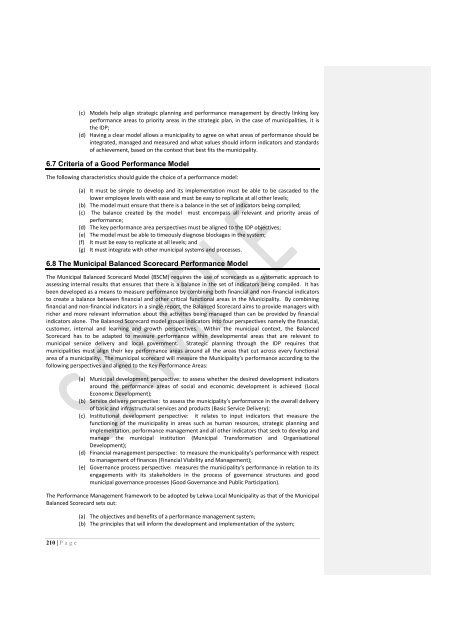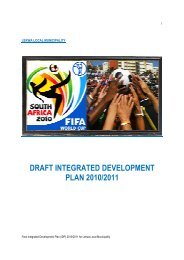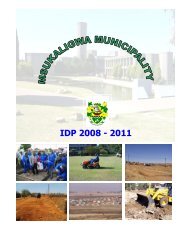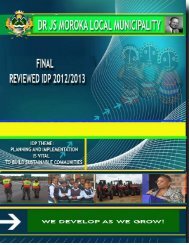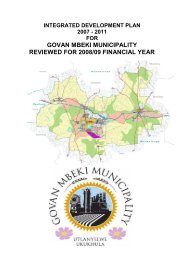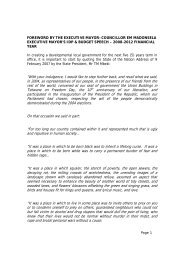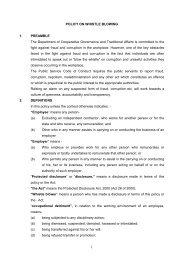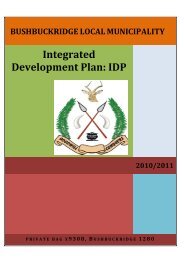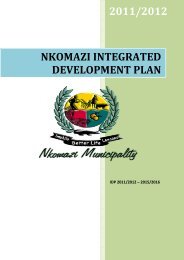Lekwa Local Municipality 2013/14 - Co-operative Governance and ...
Lekwa Local Municipality 2013/14 - Co-operative Governance and ...
Lekwa Local Municipality 2013/14 - Co-operative Governance and ...
You also want an ePaper? Increase the reach of your titles
YUMPU automatically turns print PDFs into web optimized ePapers that Google loves.
(c) Models help align strategic planning <strong>and</strong> performance management by directly linking keyperformance areas to priority areas in the strategic plan, in the case of municipalities, it isthe IDP;(d) Having a clear model allows a municipality to agree on what areas of performance should beintegrated, managed <strong>and</strong> measured <strong>and</strong> what values should inform indicators <strong>and</strong> st<strong>and</strong>ardsof achievement, based on the context that best fits the municipality.6.7 Criteria of a Good Performance ModelThe following characteristics should guide the choice of a performance model:(a) It must be simple to develop <strong>and</strong> its implementation must be able to be cascaded to thelower employee levels with ease <strong>and</strong> must be easy to replicate at all other levels;(b) The model must ensure that there is a balance in the set of indicators being compiled;(c) The balance created by the model must encompass all relevant <strong>and</strong> priority areas ofperformance;(d) The key performance area perspectives must be aligned to the IDP objectives;(e) The model must be able to timeously diagnose blockages in the system;(f) It must be easy to replicate at all levels; <strong>and</strong>(g) It must integrate with other municipal systems <strong>and</strong> processes.6.8 The Municipal Balanced Scorecard Performance ModelThe Municipal Balanced Scorecard Model (BSCM) requires the use of scorecards as a systematic approach toassessing internal results that ensures that there is a balance in the set of indicators being compiled. It hasbeen developed as a means to measure performance by combining both financial <strong>and</strong> non-financial indicatorsto create a balance between financial <strong>and</strong> other critical functional areas in the <strong>Municipality</strong>. By combiningfinancial <strong>and</strong> non-financial indicators in a single report, the Balanced Scorecard aims to provide managers withricher <strong>and</strong> more relevant information about the activities being managed than can be provided by financialindicators alone. The Balanced Scorecard model groups indicators into four perspectives namely the financial,customer, internal <strong>and</strong> learning <strong>and</strong> growth perspectives. Within the municipal context, the BalancedScorecard has to be adapted to measure performance within developmental areas that are relevant tomunicipal service delivery <strong>and</strong> local government. Strategic planning through the IDP requires thatmunicipalities must align their key performance areas around all the areas that cut across every functionalarea of a municipality. The municipal scorecard will measure the <strong>Municipality</strong>’s performance according to thefollowing perspectives <strong>and</strong> aligned to the Key Performance Areas:(a) Municipal development perspective: to assess whether the desired development indicatorsaround the performance areas of social <strong>and</strong> economic development is achieved (<strong>Local</strong>Economic Development);(b) Service delivery perspective: to assess the municipality’s performance in the overall deliveryof basic <strong>and</strong> infrastructural services <strong>and</strong> products (Basic Service Delivery);(c) Institutional development perspective: it relates to input indicators that measure thefunctioning of the municipality in areas such as human resources, strategic planning <strong>and</strong>implementation, performance management <strong>and</strong> all other indicators that seek to develop <strong>and</strong>manage the municipal institution (Municipal Transformation <strong>and</strong> OrganisationalDevelopment);(d) Financial management perspective: to measure the municipality’s performance with respectto management of finances (Financial Viability <strong>and</strong> Management);(e) <strong>Governance</strong> process perspective: measures the municipality’s performance in relation to itsengagements with its stakeholders in the process of governance structures <strong>and</strong> goodmunicipal governance processes (Good <strong>Governance</strong> <strong>and</strong> Public Participation).The Performance Management framework to be adopted by <strong>Lekwa</strong> <strong>Local</strong> <strong>Municipality</strong> as that of the MunicipalBalanced Scorecard sets out:(a) The objectives <strong>and</strong> benefits of a performance management system;(b) The principles that will inform the development <strong>and</strong> implementation of the system;210 | P a g e


